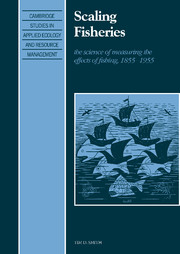Book contents
- Front Matter
- Contents
- Acknowledgements
- Preface to the Paperback Edition
- References
- Units used in the text
- Part I INTRODUCTION
- Part II DEVELOPING METHODS, 1855–1940
- Part III THREE PARTIAL THEORIES, 1940–1955
- 7 Middling in size
- 8 How many parents are enough?
- 9 Steady state yield
- 10 Integration: self-regenerating populations and the bionomic ecosystem
- Notes
- References
- Index of people
- Subject index
10 - Integration: self-regenerating populations and the bionomic ecosystem
Published online by Cambridge University Press: 22 September 2009
- Front Matter
- Contents
- Acknowledgements
- Preface to the Paperback Edition
- References
- Units used in the text
- Part I INTRODUCTION
- Part II DEVELOPING METHODS, 1855–1940
- Part III THREE PARTIAL THEORIES, 1940–1955
- 7 Middling in size
- 8 How many parents are enough?
- 9 Steady state yield
- 10 Integration: self-regenerating populations and the bionomic ecosystem
- Notes
- References
- Index of people
- Subject index
Summary
The concept of a generalized theory of population dynamics is probably premature and may even be illusory.
Raymond Beverton and Sidney Holt 1957The 'overfishing problem' has its roots in the economic organization of the industry.
H. Scott Gordon 1954The century since the Norwegian government had hired G. O. Sars to investigate the fluctuations in the Lofoten Island cod fishery saw the development of many national and several international fishery research programs. Although these were too frequently focused on the needs for immediate answers to short-term management problems, many of the programs produced fundamental insights into the effects of fishing on marine fish and mammal populations. These insights were primarily in the area that Kyle in his 1905 analysis of overfishing termed ‘the problem of the decrease of fish.’ This problem, which Kyle had argued ‘can be solved if certain factors are known,’ was in fact solved in three different ways by the early 1950s, as described in chapters 7, 8, and 9. In 1954, three papers elaborating these three partial theories were published. Schaefer (1954a) defined the surplus production theory with his application of the logistic equation to the California sardine fishery in his paper ‘Some aspects of the dynamics of populations important to the management of the commercial marine fisheries.’ Ricker (1954) defined the spawner and recruit theory, using data from populations of herring, haddock, salmon, starfish, and fruit flies in his paper ‘Stock and recruitment.’
- Type
- Chapter
- Information
- Scaling FisheriesThe Science of Measuring the Effects of Fishing, 1855–1955, pp. 324 - 336Publisher: Cambridge University PressPrint publication year: 1994



